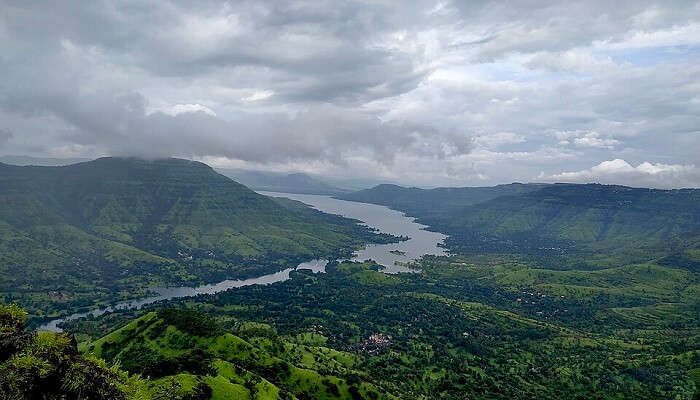Kapaleeswarar Temple: Everything You Need To Know
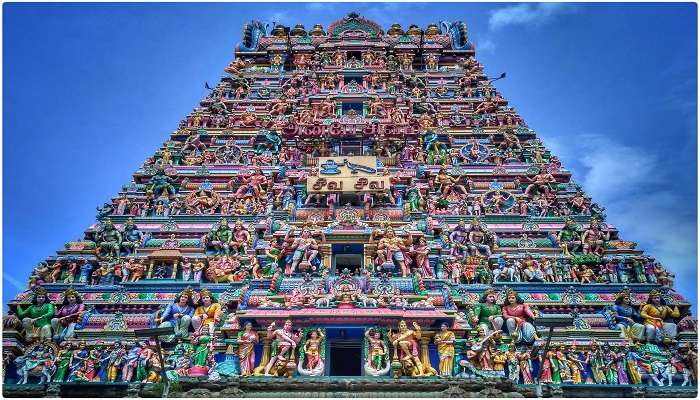
Built around the 7th century AD, the Kapaleeswarar Temple is dedicated to Lord Shiva. It stands firm, tall and proud amid the sprawling city of Chennai in Mylapore. As devotees and history buffs alike, you can step into a haven for saying prayers and seeking blessings. Exuding vibrant and positive vibes the temple is visited by many zealots worldwide. Remember to add this religious attraction to your itinerary as you plan your trip to Chennai. With this blog, you delve into the history, architecture, festivals, and more.
Kapaleeswarar Temple History
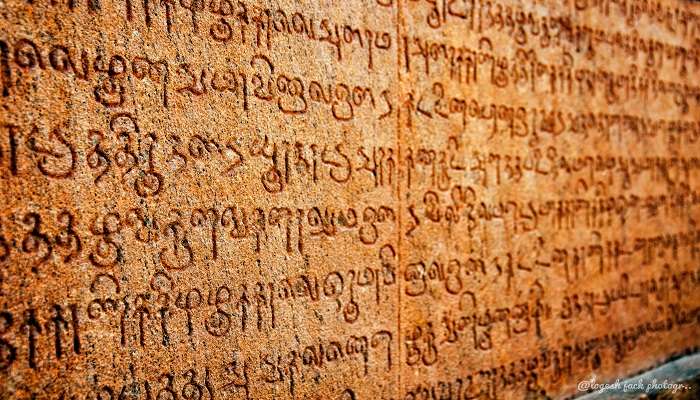
The Kapaleeswarar Temple is usually considered to have been built in the 7th century CE by the ruling dynasty of the Pallavas. This is according to a set of hymns passed on by the Nayanar saints. Both Nayanar Thirugyana Sambandhar and the saint Arunagirinathar have mentioned that the Kapaleeswarar Temple is located by the sea shore, which indicates the same temple because Mylapore is very close to the beach. The temple houses inscriptions that date back to the 12th century. In 1906, a 120 ft temple gopuram or gateway tower was built with stucco figures and sculptures adorning it. In addition, it is being maintained, run and administered by the Hindu Religious and Endowment Board of the Government of Tamil Nadu.
Must Read: Things To Do In Chennai
Legends Of Kapaleeswarar Temple
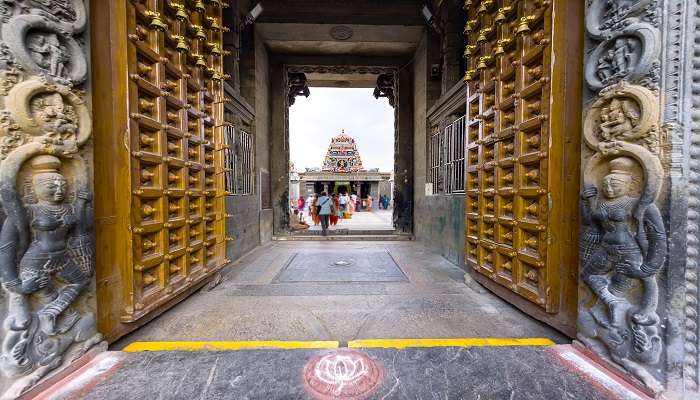
According to the Puranas, Lord Brahma visited Lord Shiva at the top of Mount Kailash and failed to show respect for him. Because of this, Lord Shiva incapacitated one of Lord Brahma’s five heads (kapalas) and kept the skull for himself. As an act of repentance, Lord Brahma visited the spot at Mylapore where the temple now exists and installed a Shiva Linga to please Shiva.
According to another legend, Lord Shiva’s consort Parvati was cursed to take the form of a pea-hen and therefore did penance to retrieve her original form by pleasing Shiva. Moreover, Goddess Parvati gave Lord Murugan, her second son, his famous spear or “Vel” for the destruction of a terrible demon. Shukra is also said to have worshipped here to regain his lost eye, which Vamana, in the form of Lord Vishnu, damaged using a dharba grass. At this spot, Thirugyana Sambandhar also rescued and revived the daughter of Sivanesa Chettiar Angam Poompavai, who died due to a snake bite. Lastly, a Nayanar saint called Vayilar attained moksha or salvation at this place.
Architecture And Paraphernalia: Kapaleeswarar Temple
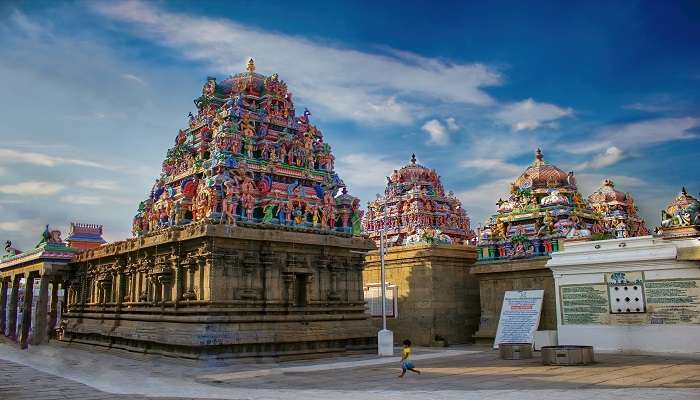
- The temple follows the typical architectural style of the Dravidians, with the gopuram overpowering all other buildings on the street on which it sits.
- The temple has two entrances marked by either side of the gopuram.
- There are two gopurams in the temple. While the eastern gopuram is taller, at about 40 m, the western gopuram faces the temple tank.
- The paraphernalia of the temple includes vehicles or vahanas, such as the adhikaranandi, the bull, peacock, elephant, bandicoot, parrot and goat, with a new golden chariot as being the latest addition to the collection of vehicles for the deities.
- The deities in the form of the ‘utsava murthys’ or celebratory idols are seated on the chariots, and then a procession is made around the temple.
- The chariot and the deities are all grandly decorated with flowers and jewellery.
- The temple also has a peacock and a peahen caged inside, symbolising that Goddess Parvati came here in the form of a peahen to do Lord Shiva’s penance.
Suggested Read: Famous Temples In Chennai
Temple Tank At Kapaleeswarar Temple
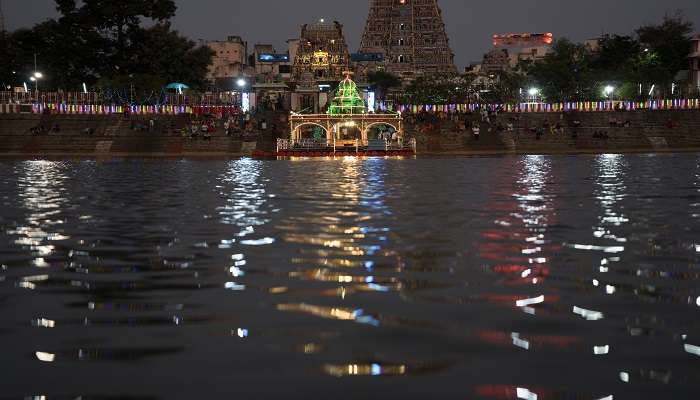
The temple tank of the Kapaleeswarar Temple or the ‘theppakulam’ lies towards its west It is one of the most ancient and well-maintained tanks in a temple in the city of Chennai. Mor,eover, the tank features a sixteen-pillared, granite-roofed structure in the middle, known for its significance for the 3-day annual float festival. when the utsava murthies of Kapaleeswarar and Karpgambal are taken around the temple tank, accompanied by the chanting of various Vedic mantras and hymns. In recent years, a sizeable 2,150-meter-long pavement was built around the tank.
Religious Practises At Kapaleeswarar Temple
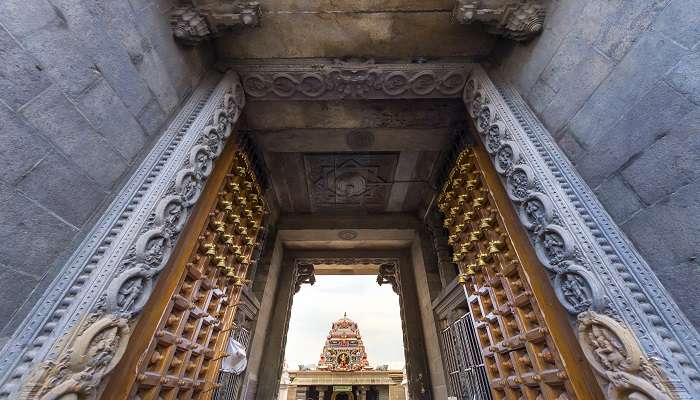
The priests of the temple are Shaivaite and belong to the Shaiva community, and they perform puja and rituals every day as well as during important festivals when special pujas are performed. The temple rituals and prayers are performed 6 times in a day,
6:00 am – Ushathkalam
9:00 am – Kalasanthi
1:00 pm – Uchikalam
5:00 pm – Sayarakshai
7:00 pm – Irandamkalam
9:00 pm – Ardha Jamam
The Rahu Abhishekam follows a separate calendar, and it is conducted twice a day at 11:30 am and 5:30 pm for Rahu. It is also conducted additionally two times at different times of the day. The ritual worship is always accompanied by the playing of South Indian musical instruments like the windpipe instrument), Ttamil percussion drum, and chanting of Vedic hymns in Sanskrit by priests. Devotees often prostrate themselves in front of the deities at this eclectic moment. Each pooja comprises 4 steps:
- Abhisheka: Ritual sacred water bath
- Alankaram: Decoration with flowers, jewellery, clothing, paraphernalia
- Neivethanam: Rritual of an offering of sacred food
- Deepa Aradhanai: Ritual of the sacred waving of lamps
Some weekly rituals are also conducted on Mondays and Fridays along with fortnightly rituals, like pradosham (removal of one’s doshas or malefic). Hence, plan a visit to Kapaleeswarar Temple in a way you participate in the daily rituals.
Suggested Read: Tourist Places Near Chennai
Festivals At Kapaleeswarar Temple

The period of mid-March to mid-April corresponds to the Tamil month of Panguni- Brahmotsavam (annual festival). The Kapaleeswarar Temple celebrates this nine-day festival as a Panguni Peruvila (festival of Spring). During the Brahmotsavan, the idols of the Goddess Karpagambal and Sri Kapaleeswarar are decorated with jewellery and clothes. The utsava moorthies are mounted on the various vehicles and then taken around the temple complex and the water tank in a clockwise circumambulation. This is repeated over the remaining nine days with the same murthies, but with different vehicles.
The Arupathimoovar Festival is usually heralded as their most crucial procession. This has been named after the 63 Nayanar saints. All 63 Nayanar saints follow the Kapaleswarar idol in the form of idols.
During the Car Festival, Brahma is shown driving the chariot for Shiva. The chariot is grandly decorated with flowers, statues, and jewellery. Lord Kapaleeswarar is shown holding his bow and seated on a throne. Goddess Karpagambal is seated alongside Lord Kapaleeswarar. Many people throng to the temple just to participate in pulling this chariot by tugging along the long ropes attached to it.
Further Read: Fun Places To Visit In Chennai
Make a trip to the Kapaleeswarar Temple in Mylapore if you are visiting Chennai and South India – you won’t regret the historical, cultural and spiritual experience that you get over there. Do not forget to plan your trip to Chennai which is an amazing melting pot of culture with temples and gorgeous historical places to visit all around. Plan your trip with your loved ones today and have the time of your life.
For our editorial codes of conduct and copyright disclaimer, please click here.
Cover Image Source: Shutterstock
Frequently Asked Questions About Kapaleeswarar Temple
Who constructed the Kapaleeswarar Temple in Mylapore, Chennai?
The Kapaleeswarar Temple in Mylapore, Chennai is thought to have been built by Mayillai Muthaippa Mudaliar in the 16th century AD.
What are the Kapaleeswarar Temple timings?
The Kapaleeswarar Temple is open from 5:00 AM to noon and from 4:00 PM to about 9:30 pm.
Who are the deities at the Kapaleeswarar Temple in Mylapore, Chennai?
The main deities are an ancient Shiva Linga called Kapaleeswarar, and an idol of Mother Parvati, Goddess Karpagambal.
Is photography allowed in Kapaleeswarar Temple?
No, photography is frowned upon in the Kapaleeswarar Temple, as it is a religious site. However, tokens are available for carrying cameras inside the temple premises.
What is the legend associated with the Kapaleeswarar Temple?
The legend associated with this temple is that Goddess Parvati was cursed to take a form of a peahen on earth, and she chose this spot to do penance of Lord Kapaleeswarar in the form of a peahen so that she could redeem her body.
People Also Read:
Things To Do In Tamil Nadu Tourist Places To Visit In Tamil Nadu Temples To Visit In Tamil Nadu
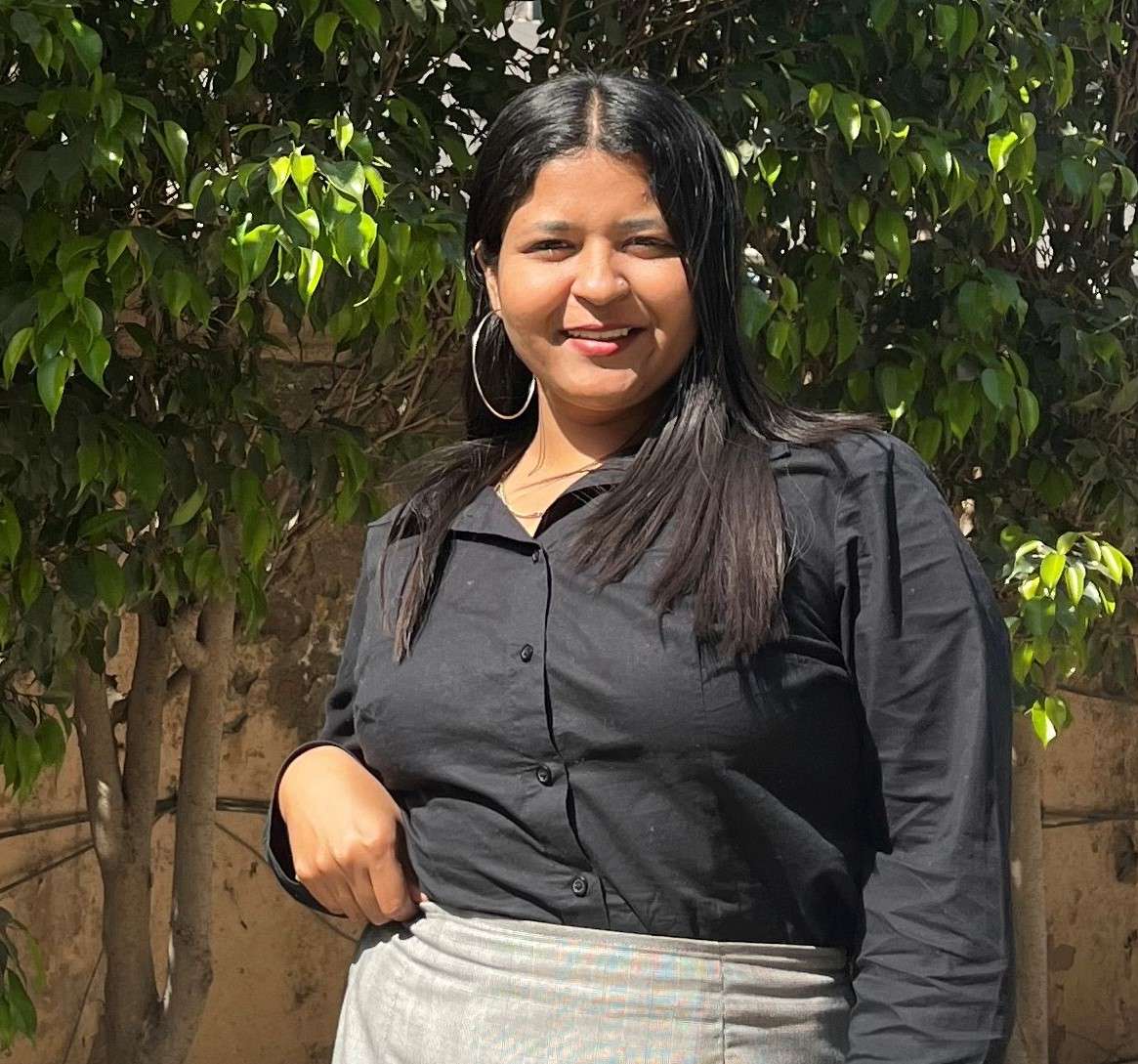
Embrace the essence of surreal places around the world through perfect narratives with a touch of imagination. As a content writer, I weave my ideas and words together to create a vivid picture of alluring destinations. Embark on limitless adventures as you read thrilling travel stories.




